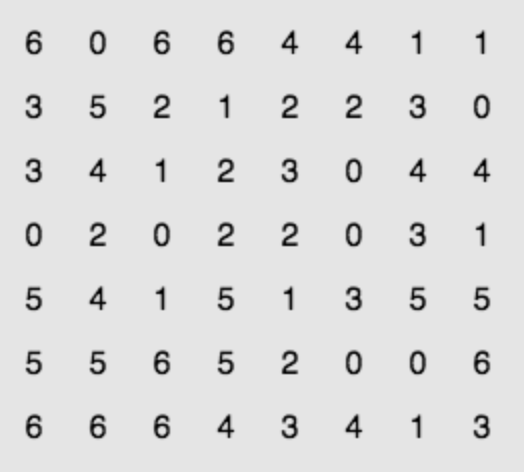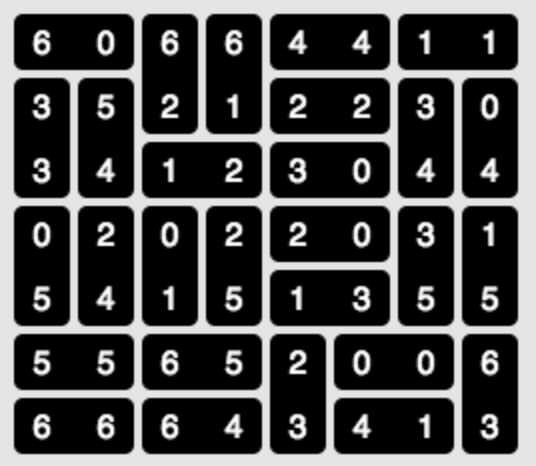Lab Assignment #1
Dominosa puzzle
SAT vs ASP
Introduction
 |
 |
| Initial state |
Solved puzzle: all
tile arrangements are unvealed |
The puzzle can be parameterized by the number n of digits, from 0 to n-1, being the usual domino game the case n=7.
Exercise (combinatorics): prove that for n different digits we can always arrange all the corresponding tiles in a grid of (n+1)*n digits. For instance, in the case of, we have a grid of n=8*7.
What to do
- SAT: write a program called dominosa in any
programming language of your choice (C, java, python,
caml, prolog, etc). This program can be used in two
ways.
Solving mode: dominosa <inputfile>
This takes an ASCII file with the grid of digits. The input format will be like the following for the example above:
7
6 0 6 6 4 4 1 1
3 5 2 1 2 2 3 0
3 4 1 2 3 0 4 4
0 2 0 2 2 0 3 1
5 4 1 5 1 3 5 5
5 5 6 5 2 0 0 6
6 6 6 4 3 4 1 3
where the first number is the value n=7 and, after that, we have n*(n+1) digits separated by spaces or intros. Your program will generate a DIMACS file (as explained in class) and make an external call to clasp to get a solution. It will also decode back the clasp output and print the tile directions as follows:
><vv><><
vv^^><vv
^^><><^^
vvvv><vv
^^^^><^^
><><v><v
><><^><^where we use the notation:
>< - represents the location of an horizontal tile and
v - represents the location of a vertical tile
^
Generator mode:dominosa -g <n>(removed)
- ASP: write an ASP encoding of the same problem and use clingo to solve the puzzle. In this case, the pretty printing is not needed (assuming that the predicate representation you choose is meaningful and readable) but you will need an extra program to transform the input files into ASP facts for the representation you choose.
File examples.zip contains
a set of benchmarks of different sizes (from n=2 to 10), where domN.txt is the input
file and solN.txt
its corresponding solution, being N
a pair of digits representing the number n of different
symbols.
If you want to push it forward, file examples2.zip contains larger
benchmarks domN.txt,
all of them correctly formed, but for which more than
one solution may exist. Accordlingly, files solN.txt contain one
of the possible solutions in each case. To check that
another potential solution is correct you can use the
python program checker.py
as, for instance, in:
checker.py dom30.txt sol30.txt
Assessment & delivery
The maximum grade for this exercise (1a)
is 1 point =10% of the course. The deadline for
delivery is Friday, March 23rd,
2018 using the MOODLE assignment. Exercises
can be made by groups of 2 students at most. If so, only
one student is required to deliver the files in moodle,
but all source files must contain the names of the two
group members.
Delivery: upload all files in a .zip including a
README.txt describing how to compile the code for the SAT
interface programs (and the solution to the combinatorics
exercise). Regardless of the programming language you
choose, avoid using non-standard libraries.